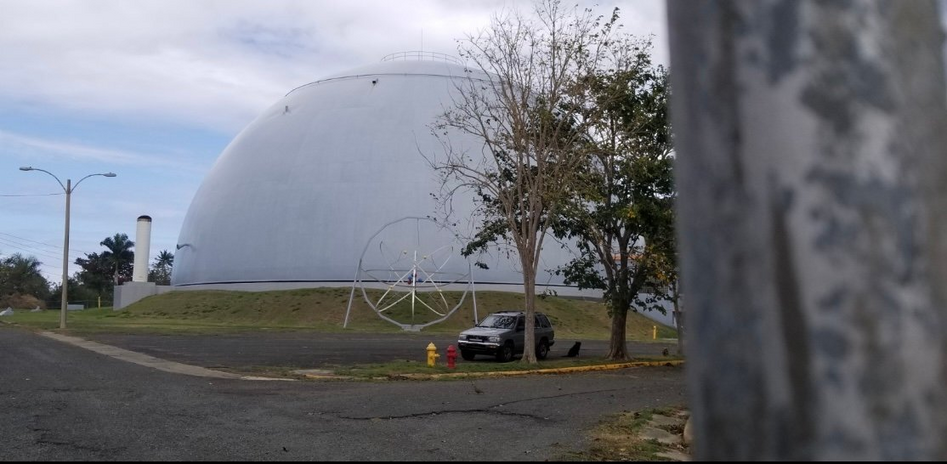Have you ever wondered why Domes Beach is called that way? According to the Merriam-Webster dictionary, a dome means a large hemispherical roof or ceiling. Therefore, what is the relationship between a dome and this beach? Puerto Rico is known for its clear beaches and great waves to surf. Domes Beach, which is located in the town of Rincón, is visited by numerous locals and tourists that attend the surfing competitions that are hosted throughout the year. There, beachgoers can also admire the Punta Higüero Lighthouse, which was constructed in 1892 by the Spanish government. But behind this monument, there is another building with a green dome that stands out among the coastal environment, one that is a relic of another, more recent, era. That building was the location of the first nuclear-powered-electricity-generating facility in the Caribbean.
But before we can talk about the history of this plant, we need to talk about why nuclear plants became so important. To do this, we need to travel back to one of history’s most controversial eras: the Atomic Age. The year was 1945, and the United States had just bombed both Hiroshima and Nagasaki with a new type of weapon, the atomic bomb. This event ended the war, but it began a race for nuclear energy that was led by nations like the United States and USSR, who projected the idea of modernity and progress to the postwar world.
Thus, the island of Puerto Rico, swept away in this atomic fever, also started making plans for the start of their “Atomic Age”. In 1956, the current governor of the island, Luis Muñoz Marín, wrote a letter to Admiral Paul F. Foster, Assistant General Manager for International Activities of the Atomic Energy Commission (AEC). The letter (this is on section 8 page 7-8) stated that the island was ready for “applications of atomic energy in agriculture, in health, in industry, and power,” and that a nuclear reactor was needed for this purpose. The letter also stated that this will be “a source of electrical energy to be integrated with the power system of the [Puerto Rico] Water Resources Authority (PRWRA).” Thus, with this said, the AEC decided to bring the Boiling Nuclear Superheater (BONUS) Reactor Facility to Rincón instead of Cabo Rojo. Two reasons for this decision were: “the proximity to an already established 38,000 volts power line running through the area and the closeness of the site to the University of Puerto Rico, Mayagüez Campus, and its highly scientific oriented staff.” The rest of the reasons are on section 8, page 8 of this document. Construction for the power plant began in the early 1960s and concluded in 1964, making it the first in Latin America and the Caribbean. The BONUS plant started up in April of that same year.
The design for the plant was different from the already existing ones since the entire power plant, including the control room, was inside a 190-foot-diameter structure. With this, the idea was that the steam produced by a boiling water reactor, which normally goes straight to the turbine building, could be superheated by nuclear energy. This would make dry steam at a very high pressure that allows the use of cheaper, commercially available equipment in the plant and would greatly increase the effectiveness of it. Here is a layout of the plant in order to visualize it better.
In spite of this, its reactor suffered a mechanical failure and drew disdain from environmentalists. For this reason, and the expensive cost of fixing the plant, the BONUS project was terminated in 1968. The AEC stated that the plant had accomplished its purpose and that the information collected from BONUS would be effected for new power plants in the United States. The fuel, control rods, and the shims were removed and sent to the United States. Some of the other equipment was placed below the reactor before it was sealed, but the entire plant remained in Rincón. Today, the plant is constantly monitored and preserved by the US Department of Energy.
This was not the only time the island considered bringing nuclear power to the island. According to the American Nuclear Society, after its decommission, PRWRA considered a more conventional power plant for the island. This time, it would be located on the northern coast of the island, in Islote, Arecibo. In 1970, the authority ordered two water reactors to begin the new project but in 1978, it was discontinued. This signaled the end of Puerto Rico’s endeavor into the Atomic Age. The next time you visit Domes Beach in Rincón, remember the history behind the BONUS nuclear plant and how Puerto Rico was a part of the Atomic Age.

Today the dome is seen with a sculpture of an atom in the front. Also seen here is the car of the guard that is on duty 24/7. (Photo GQ)

At the entrance of the museum is a mural of the history of the discovery of radiation and important scientists that have contributed to it. (Photo GQ)



